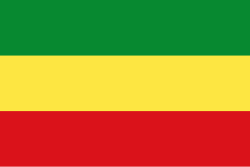Flag

A flag is a piece of coloured cloth with a special design that is put on a pole as a symbol.
Flags first appeared more than 2000 years ago in China, and in Europe under the Roman Empire. Flags also have meanings, the colors and the shapes they use. For example, the Japan flag has a white backgroud and a red circle in the middle. The red cirle is the red sun and the white background means honesty and purity. [1]
There are many types of flags: State
- A National Flag is the symbol of a country (nation). For example, the national flag of the United States is the Stars and Stripes; the flag of the United Kingdom is the Union Flag' or 'Union Jack; the national flag of Libya was the only flag in the world to have one colour and no design; the national flag of Canada is The Maple Leaf flag.
- An Ensign is a special type of national flag for use on ships. Different kinds of ships often use different kinds of ensigns. For example, warships use a naval ensign which is usually different from the ensigns used by other ships.
- A Rank Flag is used by the head of state, as well as by a senior officer of the navy, army or air force, to show where he or she is.
- In the past, soldiers carried beautiful flags to war. Today these ceremonial flags are used only at military parades.
- Some states, provinces, cities and towns have their own flags. For example, all 50 states within the United States have their own state flags.
- A Signal Flag is a flag used by ships to send messages to other ships or to people on land. Every ship keeps many different signal flags for use in different situations. Signal flags are also used for racing.
- Flags are sometimes also used to represent a business, a sports team, a school, a political party, or other organizations.
Flag Media
Bronze flag Derafsh Shahdad found in Shahdad, Iran, third millennium BC
Sujagi of Eo Jae-yeon, captured in 1871
Flags at half-mast outside Central Plaza, Hong Kong, after the 2008 Sichuan earthquake. The Flag of Saudi Arabia is exempted.
The Danish national flag (Dannebrog) waving in Samsø
The Flag of Ethiopia's colours inspired the colours of many African national flags.
Standard for the UK's Royal Air Force, the Ensign of the RAF displays the RAF roundel that is also displayed on the fuselage and wings of British warplanes.
Related pages
| Wikimedia Commons has media related to Lua error in Module:Commons_link at line 62: attempt to index field 'wikibase' (a nil value).. |
References
- ↑ "Japan aesthetic- - The meaning of Japanese flag | Facebook". www.facebook.com. Retrieved 2023-08-28.







